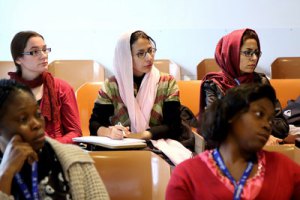By Elizabeth Simmons

Dr. Simmons presenting at ICTP, 2015
In many nations, there are far fewer women than men in physics studies and careers. Across the US or Europe women typically make up only about 20% of professional physicists. In South Korea and Japan, the percentage is less than half this. A number of women from African countries whom I have met at ICTP have noted that they are the first to earn a PhD at or be employed as a faculty member at their institution.
What are the reasons for the gender gap? Some relate to family life: women are often expected to do most of the household and caregiving tasks within a family, even if they work outside the home. This makes it challenging to have enough time for studies or to advance in a career. Others relate to socialization: media stereotypes, peer pressure, and elders’ advice often discourage young women from being pioneers in traditionally “masculine” fields such as science or mathematics. Those entering these fields can find themselves isolated or excluded, with little access to mentoring and collaborative networks. Furthermore, a Global Survey of Physicists conducted by the American Institute of Physics in association with the IUPAP Working Group on Women in Physics has revealed that women physicists in every nation have less lab space and fewer opportunities for career advancement than their male colleagues (see followup articles from 2012 and 2015).





